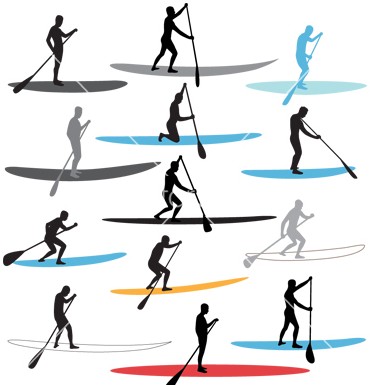
A new sport at any age forces thinking and coordination of moving body parts. You increase your brainpower when learning a new task. Stand up paddling (SUP) is the most popular new sport. It is the outdoor sporting activity that boasts the most first-time participants in the U.S. in 2013.
How did this new sport gain popularity so fast with both young and old? The history of stand up paddle is diverse, but the act of stand up paddle boarding is over a thousand years old. From Ancient Polynesia to the gondolas of Venice, Italy, paddle boarding has been a common means of simple transportation evolving into a sport that anyone can do.
If you’re near a lake, ocean or other waterway, look out and chances are that you will see people of all ages out on paddleboards. They are sitting, kneeling or standing on their boards and traveling across the water. The young ones may have two on a board, the athletes looking for a challenge are paddle surfing, and the rest are cruising around checking out the sights by themselves or on a SUP tour.
SUP offers instant appeal because it has success elements:
- Easy to use
- Simple tools—one board and one paddle
- Easy to learn. A newbie can learn from the tons of video instructions easily on the Internet.
- Low risk. The simplicity allows the user to out in easy positions and progress to stand up when ready. Paddlers can sit if they want to rest or even paddle while sitting. Falling off the paddleboard into the water is less risky than tipping over a kayak. It’s certainly easier than getting back into an overturned kayak.
- Interesting. The environment creates the challenges for the sport. A smooth flat lake makes it easy to master the basic strokes and turns. Waves increase the balancing required. There are races for paddlers who want to measure themselves against speed. Paddle surfing offers options for surfers—paddling farther away, increased the number of waves in a session and the range of surfing conditions..
The SUP paddler gains improvement in their balance, a different perspective of the water action and reaction, improved focus by executing two different types of muscle control simultaneously, and confidence by tackling and succeeding in a new sport.
In healthcare, widespread appeal to customers is often forgotten. Most consumers think of healthcare as a necessary and expensive evil. In order to engage patients in their own health, organizations need to provide a product that has the success elements of the SUP. After all, stand up paddling is thousands of years old and was used for practical operations such as fishing, transportation and war. Today, it has been reintroduced as a fun activity for all ages.
How many of the SUP success elements have you incorporated into your business?
- Simple
- Easy to learn
- Easy to use
- Risk acceptable
- Interesting
With the transformation of healthcare now taking place, healthcare providers are forced to make changes in order to comply with evolving requirements and regulations. This is causing a shift of roles for doctors and patients.
Patients need to be engaged in their own healthcare to get the best out of the system. Technology is changing the way patients seek healthcare and providers. Mobile apps allow the consumer to find care when and where it is needed. Providers have online ratings and reviews from reliable web sites that give the consumer information to select a physician that is suitable to their personal style.
Doctors are implementing electronic health records and their practices have to change their workflow and learn new systems to get the best out of the technology and deliver better care to their patients. These are the must-do tasks for physician practices to keep up with the changes. The question is how does a practice differentiate itself to provide services in an innovative way? Instead of viewing technology as an added burden, it can free the provider to deliver care at a lower cost.
Like learning a new sport or activity, it takes time and practice to streamline and improve—the equivalent of creating new paths in the brain.


Leave A Comment
You must be logged in to post a comment.